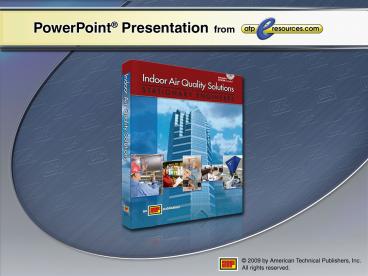Chapter 13 Building Automation Systems for IAQ Buildin - PowerPoint PPT Presentation
1 / 38
Title:
Chapter 13 Building Automation Systems for IAQ Buildin
Description:
Chapter 13 Building Automation Systems for IAQ Building Automation Systems and Controllers Operator Interface Methods Building Automation System Input and ... – PowerPoint PPT presentation
Number of Views:80
Avg rating:3.0/5.0
Title: Chapter 13 Building Automation Systems for IAQ Buildin
1
Chapter 13
- Building Automation Systems for IAQ
Building Automation Systems and Controllers
Operator Interface Methods Building Automation
System Input and Output Components Direct
Digital Control Strategies, Features, and
Algorithms IAQ Strategies and Energy
Considerations
2
Chapter 13
- Building Automation Systems for IAQ
Building Automation Systems and Controllers
Operator Interface Methods Building Automation
System Input and Output Components Direct
Digital Control Strategies, Features, and
Algorithms IAQ Strategies and Energy
Considerations
3
- Distributed direct digital control systems have
multiple CPUs at the controller level.
4
- Application-specific controllers are designed to
control only one type or part of an HVAC system.
5
- Unitary controllers are designed for simple zone
control using a standard wall-mounted temperature
sensor.
6
- Air-handling unit controllers are used when the
sophisticated control of large central-station
air-handling units is required.
7
- Variable-air-volume (VAV) air terminal unit
controllers are similar in appearance to unitary
controllers. The difference is in the factory
programming of the erasable programmable
read-only memory (EPROM) chip.
8
- Variable-air-volume (VAV) air-handling unit
controllers are used to control VAV air-handling
units in order to maintain a minimum static
pressure in supply ducts.
9
- Variable-air-volume (VAV) air-handling
controllers are used to control building space
temperature and air volume in VAV air-handling
systems.
10
- Network communication modules coordinate
communication from controller to controller on a
network and provide a location for operator
interface.
11
- Desktop personal computers (PCs), alarm printers,
notebook PCs, portable operator terminals, keypad
displays, and dumb terminals are used in large
buildings to access and troubleshoot a buildings
automation system.
12
- A building automation system with web browser
software packages allows a stationary engineer to
communicate and change settings from anywhere in
the world.
13
- Analog input devices send 4 mA to 20 mA or 0 V to
10 or 20 V signals to a building automation
systems controllers, causing a proportional
electrical signal change to output components.
14
- Temperature sensors are available in a variety of
packages and mounting configurations including
wall-mounted, duct-mounted, immersion
(well-mounted), and averaging.
15
- Humidity sensors contain a hygroscopic element
that changes physical characteristics as the
humidity changes.
16
- Piezoelectric elements (pressure-sensitive
crystals) are used in duct pressure-sensing
applications, while bellows elements are used in
many piping applications.
17
- In IAQ applications, differential pressure
sensors or pitot tubes and temperature sensors in
a duct can act as airflow measuring stations
(AMS).
18
- A digital input device signal is a binary (ON or
OFF) signal.
19
- Limit thermostats maintain a temperature above or
below an adjustable setpoint.
20
- Humidistats are digital input devices used in
ducts and indicate when a humidity setpoint has
been reached.
21
- Differential pressure switches are often used to
indicate a difference in pressure across a fan or
pump or to indicate the condition of an
air-handling unit filter.
22
- Electric/pneumatic transducers have an analog
input signal, such as 4 mA to 20 mA, from the
building automation system and an output air
pressure signal of 0 psi to 20 psi.
23
- Triac-switched controller output terminals
require an external power supply and are used to
switch alternating current (AC).
24
- Relays are used to allow low-voltage-rated triacs
of building automation system controllers to
switch line-voltage components ON and OFF.
25
- In a direct digital control system, a building
automation system controller is wired directly to
controlled components.
26
- In closed-loop control, feedback occurs among the
controller, sensor, and controlled component(s).
27
- In open-loop control, no feedback is provided
from sensors to a building automation system
controller.
28
- Setpoint is the desired value to be maintained by
a system with the desired accuracy to the
setpoint being programmed into a BAS controller.
29
- Setup and setback setpoints are values that are
active during the unoccupied mode of a building
automation system.
30
- Low-limit controls stop outside-air dampers from
closing 100 and still allow ventilation air into
a building when ventilation-air temperatures are
excessively low outside.
31
- Proportional control algorithms position a
controlled component in response to the amount of
offset experienced in a building automation
system.
32
- Derivative control algorithms determine the
instantaneous rate of change of a controlled
variable.
33
- Adaptive control algorithms are self-tuning
algorithms that are often used to correct an
overcycling control system.
34
- Acceptable indoor air quality numbers for
ventilation are detailed in ANSI/ASHRAE Standard
62.1-2007, Ventilation for Acceptable Indoor Air
Quality.
35
- CO2 levels in building spaces or zones are used
as an indicator of occupancy.
36
- A typical HVAC system increases ventilation when
CO2 levels rise to 600 parts per million (PPM) so
that levels do not exceed 1000 PPM.
37
- Economizers use outdoor air to provide free
cooling and are not practical or advisable in
hot-humid climates.
38
- In night precooling, cool outdoor night air is
used to cool a building while simultaneously
exhausting accumulated pollutants.































